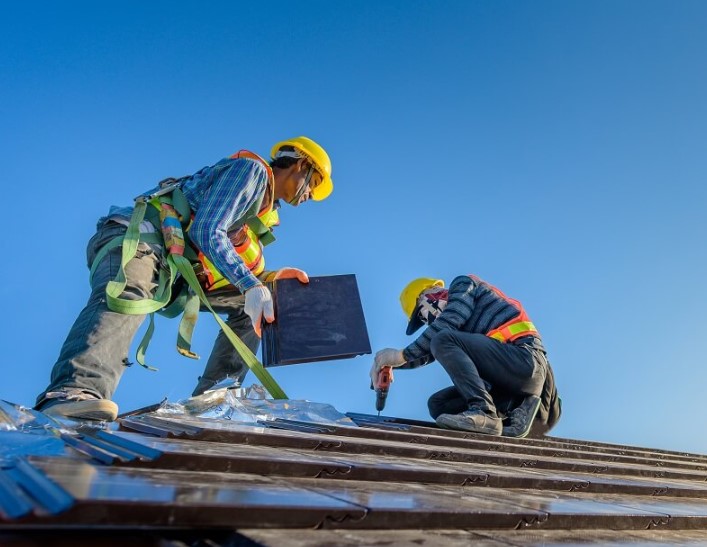
Roofing Installation: A Comprehensive Guide to a Secure and Durable Roof
1. Introduction
A well-installed roof is essential for the protection, durability, and aesthetic appeal of your home. Roofing installation is a complex process that requires careful planning, skilled craftsmanship, and quality materials. In this article, we will explore the intricacies of roofing installation, from understanding its importance to the step-by-step process involved.
2. Understanding Roofing Installation
2.1 Importance of Proper Roofing Installation
Proper roofing installation is crucial to safeguard your home against the elements. A securely installed roof acts as the first line of defense, shielding your property from rain, wind, snow, and other weather conditions. It also helps maintain a comfortable indoor environment by preventing heat loss or gain. Moreover, a well-installed roof enhances the overall value and curb appeal of your home.
2.2 Hiring Professional Roofing Contractors
To ensure a successful roofing installation, it is advisable to hire professional roofing contractors. Experienced roofers possess the necessary expertise, tools, and knowledge to handle various roofing projects. They can accurately assess your roofing needs, recommend suitable materials, and execute the installation process with precision. Additionally, professional roofers are familiar with local building codes and safety regulations, ensuring compliance and peace of mind.
3. Preparing for Roofing Installation
3.1 Assessing Roofing Needs
Before initiating the roofing installation, a thorough assessment of your roof’s condition is essential. This evaluation helps identify any underlying issues or structural weaknesses that need to be addressed. It also allows for accurate cost estimation and planning.
3.2 Choosing the Right Roofing Materials
Selecting the appropriate roofing materials is a critical aspect of the installation process. Factors such as climate, architectural style, budget, and personal preferences should be considered. Common roofing materials include asphalt shingles, metal, slate, wood, and clay tiles. Each material has its own advantages and considerations, so it is vital to choose wisely.
3.3 Obtaining Necessary Permits
In many jurisdictions, obtaining permits for roofing installation is mandatory. Local building codes dictate specific requirements to ensure safety and structural integrity. Before commencing the installation, consult with your local authorities or roofing professionals to determine the necessary permits and regulations.
4. Steps for Roofing Installation
4.1 Clearing and Preparing the Roofing Surface
Before installing a new roof, the existing roof covering, if any, must be removed. This process involves stripping off the old shingles, inspecting the roof deck for damage, and making necessary repairs. Clearing the roof surface provides a clean and stable foundation for the new roofing materials.
4.2 Installing Underlayment and Flashing
Once the roof surface is prepared, the installation of underlayment and flashing follows. Underlayment acts as an additional barrier against water penetration, while flashing protects vulnerable areas such as valleys, chimneys, and vents. Proper installation of these components ensures optimal waterproofing and prevents leaks.
4.3 Placing Roofing Materials
With the underlayment and flashing in place, it’s time to install the chosen roofing materials. Roofing materials are laid according to specific patterns and guidelines, ensuring proper coverage and alignment. The installation technique may vary depending on the chosen material, so it is crucial to follow manufacturer instructions and industry best practices.
4.4 Securing Roofing Components
As the roofing materials are placed, securing them becomes paramount. Nails, screws, or adhesives are used to affix the materials securely to the roof deck. This step ensures stability, wind resistance, and durability of the roof.
4.5 Completing Roofing Installation
After the roofing components are securely installed, the final touches are made to complete the installation. This includes addressing ridge vents, ridge caps, and other finishing details. A thorough inspection is conducted to verify the quality of the installation and make any necessary adjustments.
5. Ensuring Quality and Longevity
5.1 Regular Roof Inspections and Maintenance
To prolong the life of your roof, regular inspections and maintenance are essential. Inspections help identify potential issues, such as damaged shingles, leaks, or deteriorating flashing, allowing for timely repairs. It is recommended to conduct inspections at least once a year, preferably during spring or fall.
5.2 Dealing with Common Roofing Issues
Over time, certain common roofing issues may arise, requiring prompt attention. These issues include leaks, ice dams, damaged shingles, and clogged gutters. It is crucial to address these problems immediately to prevent further damage and maintain the integrity of your roof.
6. Conclusion
Roofing installation is a critical process that requires careful planning, professional expertise, and quality materials. By understanding the importance of proper installation, hiring experienced contractors, and following a systematic approach, you can ensure a secure and durable roof for your home. Regular maintenance and prompt resolution of any issues will further extend the lifespan of your roof, protecting your investment for years to come.
7. Frequently Asked Questions (FAQs)
Q1. How long does a typical roofing installation take? The duration of a roofing installation project varies depending on several factors, including the size of the roof, complexity of the design, weather conditions, and the roofing contractor’s efficiency. However, a standard residential roof installation can typically be completed within a few days to a week.
Q2. Can I install a new roof over the existing one? In some cases, it is possible to install a new roof over the existing one. However, it is important to consult with a professional roofing contractor to assess the feasibility and ensure compliance with local building codes. Factors such as the condition of the existing roof and the type of new roofing material will determine if this option is suitable.
Q3. How often should I have my roof inspected? Regular roof inspections are recommended at least once a year. However, it is advisable to schedule additional inspections after severe weather events, such as storms or heavy snowfall. Timely inspections can help identify potential issues and prevent costly damage in the long run.
Q4. What are the signs of a roof leak? Signs of a roof leak include water stains on the ceiling or walls, peeling paint or wallpaper, mold or mildew growth, damp odors, and visible water dripping or pooling. If you notice any of these signs, it is crucial to address the issue promptly to prevent further damage to your property.
Q5. How long can I expect my new roof to last? The lifespan of a roof depends on various factors, including the type of roofing material, installation quality, maintenance, and local climate conditions. On average, asphalt shingle roofs can last 20 to 25 years, while metal roofs and tile roofs can last 40 to 70 years or more with proper care.
Partner Site : SEO Services, Movie News, Real Estate News, Business News Today, Hot News Today, Get Auto Repair, Business Franchise, News Technology, Fashion Sports Shoes, Health News
You May Also Like

Strengthening Education: PAFI’s University Partnerships
July 19, 2024
Savings Made Simple – How Discount of All Furniture Accessories Coupons Can Help You
October 3, 2023

